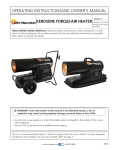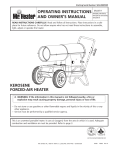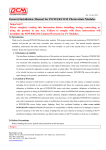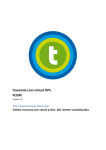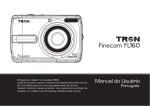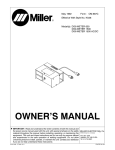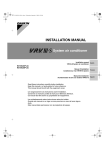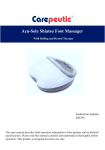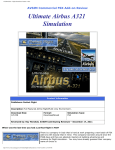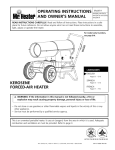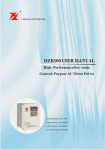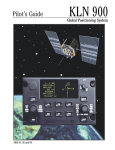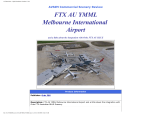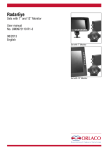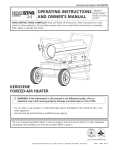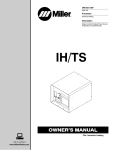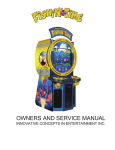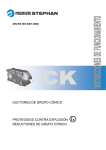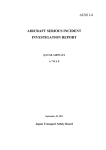Download Flight Safety magazine Jan-Feb 2000 - page51
Transcript
RULES & REGS Q. May an instructor permit a student to carry passengers while flying as pilot in command? A. CAR 5.72 specifies that an instructor must not Q. May a pilot allow any passenger who is not a licensed pilot to taxi an aircraft anywhere on an aerodrome? A. No. CAR 229 stipulates that an aircraft shall not be taxied anywhere on an aerodrome by a person other than a licensed pilot whose licence is endorsed for the particular type of aircraft concerned or a person approved by CASA in accordance with the terms and 1. 4. 6. 7. 8. 17. 18. 20. 21. 25. 28. 29. 30. 31. 33. 35. 37. 39. 40. 42. 43. 44. 45. 46. 2. 3. 4. 5. 9. 10. 12. 13. 14. 16. 17. 19. 20. 22. 23. 24. 26. 27. 31. 32. 34. 35. 36. 38. 40. 41. 43. people may be guilty of an offence against a provision of the CAR’s. Note that CAR 282(6) provides that a person is not guilty of an offence if they can provide evidence that they were not a party to, or knowingly concerned in, the act or omission charged, and that evidence is not rebutted by the prosecution. old maintenance release at the time that a maintenance release inspection is commenced, is it permissible to fly the aircraft using the old maintenance release prior to a new maintenance release being issued? A. No. CAR 47(5) provides that a maintenance release for an aircraft stops being in force from the moment that a maintenance release inspection of the aircraft begins. Q. What does the following standard hand signal indicate when it is made by ground personnel marshalling aircraft? Q. If an aircraft is flown, lands or is used in contravention of a provision of the Civil Aviation Regulations, whom among the following people may be guilty of an offence against that provision? a) The owner of the aircraft? b) The operator of the aircraft? c) The hirer of the aircraft? d) The pilot in command of the aircraft? e) Any other pilot of the aircraft? Down Speed giving an adequate margin over the stalling speed during takeoff. True outside air temperature (abbrev). Temperature in front of first stage turbine nozzle vanes (abbrev). Instrument flight rules. Propeller pitch-changing mechanism. Take-off runway available plus length of stopway available. Alto cumulus (abbrev). Zero OKTAS (abbrev). Radio frequency between 3-30MHz Unit measuring AC current. A cam follower. Mode control panel (abbrev). Restriction in a tube designed to speed up the flow of fluid. Cirrocumulus (abbrev). Maximum weight of an aircraft at take-off (abbrev). Estimated time of arrival (abbrev). Estimated time of departure (abbrev). Computerised long-range navigation system entirely independent of outside signals (abbrev). Regulations that govern visual flight (abbrev). Clearway (abbrev - 3 letters). Notice to airmen. Network of automatic weather stations (abbrev). Landing weight (abbrev). Ground-based transmitter which emits an all directions signal (abbrev). Directional gyro (abbrev - 2 letters). A component in an electrical system which converts AC to DC (abbrev). Rotation speed. a) Stop. b) Turn to your left. c) Chocks away. d) Start engine. A. c) CAO 20.3, Appendix 1 gives examples of standard hand signals to be used by ground personnel marshalling aircraft. CROSSWORD no. 12 1 2 3 5 4 6 7 8 11 12 9 13 14 15 17 18 21 26 16 19 20 22 25 10 23 24 27 28 29 31 32 30 33 35 34 36 37 38 39 40 44 41 45 42 43 46 Send your completed crossword entry by 18 February to the editor, Flight Safety Australia, PO Box 2005, Canberra ACT 2601 for a chance to win $100 worth of aviation publications. Answers will be published in the next issue. flig ht safet y aust r alia, jan uary-february 2000 5 1 c h e c k 11. 14. 15. Across A three hourly aerodrome weather forecast (abbrev). Weight of the aircraft at lift-off (abbrev). Outside air temperature (abbrev). Flight service (abbrev). Violent weather can be produced in this tropical zone (abbrev). Low grey uniform clouds. Helicopter landing site (abbrev). Radio frequency between 300 and 3000 MHz (abbrev). Actual speed of an aircraft, relative to the air (abbrev). Visual meteorological conditions (abbrev). Manoeuvring speed (abbrev). Closing angle (abbrev). Rain. Angle between track made good and planned track (abbrev). Crosswind (abbrev). Dense individual and well defined domes of cloud. Chart used for visual navigation with detail around aerodromes (abbrev). Actual mean sea level pressure at any one place (abbrev). Airline transport pilot licence (abbrev). Unit of measurement (abbrev). A measure of electrical power. A sideways movement of an aircraft due to wind. Instrument giving artificial reference of attitude in pitch and roll (abbrev). Design speed for maximum gust intensity. A track made good (abbrev). Radio navigation device (abbrev). Deduced reckoning (abbrev). Q. If an aircraft still has several hours left on its A. (f) CAR 281(2) provides that all of the above S a f e t y permit a student pilot to carry passengers while flying as pilot in command unless the flight takes place solely within the student pilot area limit, and the student pilot has passed a general flying progress flight test and a basic aeronautical knowledge exam for aircraft of the category used for the flight. f) All of the above? conditions of the approval. FLYING OPS S a f e t y c h e c k 1. 2. 3. 4. 5. 6. Which rule applies to the occupancy of a control seat by a passenger of a dual controlled aircraft? a) Carriage of a passenger in a control seat is prohibited. b) A passenger may not occupy a control seat unless the control column is removable. c) A passenger may occupy a control seat if he/she wears a seat belt at all times and there is satisfactory communication between the pilot and the passenger. d) A passenger may occupy a control seat if he/she is briefed not to interfere with the controls, and there is satisfactory communication at all times between the pilot and the passenger. One situation in which a passenger is required to wear a seat belt is when flying: a) Below 5000ft AMSL. b) Below 1000ft AGL. c) Below 1000ft AMSL. d) Over water. The minimum height an aircraft is permitted to fly over a populated area is: a) 1000ft above the highest object within a 600 metre radius from a point vertically below the aircraft. b) 1000ft above the highest object within a 1000 metre radius from a point vertically below the aircraft. c) 1000ft above the highest terrain 5nm either side of the track. d) 500ft above the highest terrain within a “lane of entry”. Take-off distance required will increase if there is an increase in: a) Headwind. b) Humidity. c) Down-slope. d) Air density. Take off safety speed is provided to ensure : a) The lowest speed at which the aeroplane may become airborne. b) The best angle of climb following take-off. c) The greatest rate of climb following takeoff. d) That adequate control is available if engine failure occurs following take-off. If the static vent system became blocked during a climb, what instrument indication would confirm the blockage, with a zero reading? a) The vacuum indicator. a) The altimeter. a) The airspeed indicator. 7. 8. 9. 10. 11. 12. a) The vertical speed indicator. When no specific instructions are available the correct fuel-air mixture setting for take-off at a high density altitude aerodrome would be: a) That which gives the least RPM drop during the magneto check. b) The richest possible that gives smooth running at take-off power settings. c) That which gives peak EGT at take-off power settings. d) Always full rich. One risk of operating an engine with the oil temperature above the upper limit is that : a) The oil cooler passages may become obstructed. b) Spark plug electrodes may become oiled. c) Localised oil pressures may become excessive. d) Lubrication of some parts may become inadequate. A flight is to be conducted in a designated remote area. Continuous VHF communications cannot be maintained. When would carriage of serviceable HF radio communications equipment be mandatory for such a flight? a) When an emergency locator transmitter (ELT) is not carried. b) When a second VHF radio communication system is not carried. c) When pyrotechnic distress signals are not carried. d) Under all circumstances. To maintain VMC when flying in Class C airspace at 2500ft AMSL the minimum horizontal separation from cloud is: a) 500 metres. b) 600 metres. c) 1500 metres. d) Clear of cloud. Consignment of dangerous goods may be accepted by a charter pilot provided he has completed an approved training course within the preceding: a) 3 years. b) 5 years. c) 18 months. d) 2 years. For which flights must a passenger list be completed and left for retention at the aerodrome of departure? a) All charter flights. b) All flights in controlled airspace. c) All aerial work flights of more than 30 minutes duration carrying passengers. d) All flights carrying more than ten passengers. Answers page 56 5 2 flig ht safet y aust r alia, january-february 2000 MAINTENANCE 1. A wooden propeller is rotated or driven by: a) The lugs on the crankshaft flange. b) The bolts through the hub of the prop. c) The bolts and the lugs together. d) The friction between the prop hub and the crankshaft flange. 2. On a Piper Cherokee, in flight wing heaviness is corrected by: a) Lowering the flap on the heavy side. b) Drooping the aileron. c) Adjusting the rear wing attach fitting. d) Fitting a ground adjustable tab to the aileron. 3. Ethylene dibromide is added to Avgas to: a) Improve the octane rating of the fuel. b) Aid in scavenging. c) Prevent detonation. d) Prevent ice formation in the fuel at altitude. 4. A Cherry max rivet with a silver coloured driving anvil would be: a) Undersized dia. b) Nominal dia. c) Oversize dia. d) Doesn’t matter, depends on the anodizing. 5. Rolled threads on flying or bracing wires can be identified by: a) Part number. b) Markings on the end of the wire. c) The threads are larger than the original shank. d) Length of the thread. Answers page 56 P i c k t h e p i c Q1. This Fokker Universal (VH-UTO) was the first aircraft operated by which Australian airline? Q4. This Boeing 707 (VH-EBA) marked the start of a long association between Qantas and Boeing. The 707 replaced the Lockheed Super Constellation that Qantas had previously been using. What was the original name given to VH-EBA, and what was it changed to? Answers page 57 flig ht safet y aust r alia, jan uary-february 2000 5 3 c h e c k Q3. This Airco DH-9 was only the second aircraft to fly between England and Australia (an eight month journey from January to August 1920), but took honours for being the first at what? S a f e t y Q2. What was the name of this unique operation, which transported beef carcasses from outlying cattle stations in north Western Australia, to the nearest available meatworks? c h e c k TOWNSVILLE APPROACH You are flying a performance category B aircraft from Georgetown (YGTN) to Townsville (YBTL) via the W841 route by day. The aircraft is fully equipped for IFR operations and the pilot is endorsed to use all aids. Your ETA TL is 0930UTC, on arrival you plan carry out the VOR DME RWY 19 instrument approach. You have obtained the following TAF for TL: TAF YBTL 170730Z 0818 22010KT 7000 SCT035 INTER 0812 17010G15KT 4000 SHRA FEW010 BKN035 T 28 26 24 22 Q 1018 1018 1019 1019 1 S a f e t y 2 3 4 With regard to the provision of an alternate or holding at Townsville, which of the following is correct? a) An alternate or 30 minutes holding must be provided. b) There is no requirement for either an alternate or holding. c) An alternate must be provided. d) 30 minutes holding or an alternate is required. You are flying in Alto-cumulus cloud at FL160. The freezing level is 10000ft. What conditions would you most likely encounter inside the cloud? a) Moderate turbulence and moderate rime icing. b) Moderate turbulence and moderate clear icing. c) Light turbulence and light rime icing. d) Light turbulence and light clear icing. What are the minimum recent experience requirements that you must satisfy to carry out the TL VOR DME Rwy 19 approach? a) An ILS within the preceding 35 days, NDB, VOR and DME arrival within the preceding 90 days. b) An ILS within the preceding 35 days and a VOR DME approach within the preceding 90 days. c) A VOR DME and NDB within the preceding 90 days. d) An ILS within the preceding 35 days. At 50 DME TL cruising at FL110 you wish to descend to 8000 feet due to icing. Which of the following is correct? a) A clearance is not required for your descent to 8000 feet because of the icing conditions. b) Once radar identified, a clearance to change levels is no longer required. c) All aircraft in CTA require a clearance to change levels. d) A clearance is only required for VFR aircraft. 5 At 20 DME, established on the 279 radial, the lowest altitude that you may descend to at this position is: a) 4900ft. b) 3500ft. c) 2500ft. d) 4800ft. 6 AT 10 DME ATC instructs you to track from your present position to the 13 DME fix on the 037 radial and enter the holding pattern and to expect the VOR DME approach for runway 19. The sector entry required is: a) A parallel entry (sector one). b) An offset entry (sector two). c) A direct entry (sector three). d) Either a parallel or offset entry. 7 The maximum speed allowed in the holding pattern without further ATC clearance is: a) 210kt. b) 175kt. c) 220kt. d) 170kt. 8 You are established on final at 13 DME, the maximum speed allowed is: a) 175kt. b) 130kt. c) 180kt till visual. d) 180kt till 8 DME then 130. e) 140kt till 8 DME then 130. 5 4 flig ht safet y aust r alia, january-february 2000 9 During the approach you find difficulty in keeping the aircraft on the desired flight path.You observe that there are cumulus clouds in the vicinity and there is virga associated with the clouds. The cause of your difficulties during the approach is most likely a: a) Thunderstorm gust front and you would report that you are experiencing strong wind shear. b) Thunderstorm gust front and you would report that you are experiencing severe wind shear. c) Microburst and you would report that you are experiencing strong wind shear. d) Microburst and you would report that you are experiencing severe wind shear. 10 Established on final at 5 DME. The PEC for your aircraft is 20 feet. The lowest altitude that you may descend to at this point is: a) 560ft. b) 580ft. c) 1800ft. d) 547ft. 11 You are not visual at the missed approach point, so you carry out a missed approach. What is the minimum obstacle clearance provided by the procedure from the MAP? a) 300ft. b) 547ft. c) 100ft. d) 800ft. Answers page 57 c h e c k flig ht safet y aust r alia, jan uary-february 2000 5 5 S a f e t y NOT TO BE USED FOR OPERATIONAL PURPOSES This chart has been reproduced for the purpose of this quiz with the permission of Airservices Australia. S a f e t y c h e c k WHAT’S THE MESSAGE? In 25 words or less, tell us what you think is the message to be inferred from this photo. The best entry will be published in the next issue. The winner will receive $50 worth of safety education products. Send your entries to the editor, Flight Safety Australia, GPO Box 2005, Canberra ACT 2601 by 18 February. How did you rate? Flying ops quiz - pg 52 1. d) CAO 20.16.3 subsection 11 para 11.1. 2. b) CAO 20.16.3 subsection 3 paras 3.1 and 4.1. 3. a) CAR para 157 (1) (a) and (3) (a). 4. b) Headwind, down-slope and increased air density all reduce the TODR. An increase in humidity is the correct answer. In humid air mass the water molecules displace the air molecules a little, effectively reducing the air density, thus increasing the take-off distance. appear to provide a reasonable indication of altitude. 7. b) Any engine rough running is an indication of some loss of power. When the reason is known, mixture too rich because of high altitudes, careful leaning for take-off and climb is acceptable. 5. d) The TOSS is never less than 1.3VS. 8. d) All limits are published for good reasons. Oil tends to thin as it becomes hot, if it becomes excessively hot it becomes excessively thin and will not do the jobs it was designed to do - lubricate, cool, clean, cushion and seal. 6. d) This is a confirming indication. With a complete static system blockage the altimeter would remain stationary but at a glance it might 9. d) AIP Gen 1.5 para 1.1 table CAO 20.11 subsection 7 (b). The table in the AIP says that an HF must be carried if an ELT is not carried. 5 6 flig ht safet y aust r alia, january-february 2000 The CAO indicates the appropriate survival equipment to be carried. Pyrotechnic distress signals are part of the survival equipment. 10. c) AIP ENR 1.2 para 2.1. 11. d) CAR para 262P (3) and para 262S (1). 12. a) CAO 20.16.1 subpara 7. Maintenance quiz - page 52 1. d) The friction between the flange and the hub rotates the prop. Because wooden propellers shrink and expand with changes in humidity, it is important that the bolt torque be checked on a regular basis. 2. a) The Piper Service Manual recommends adjusting the flap pushrod to lower the flap trailing edge on the heavy side. The rod ends must not go beyond the safety point. 3. b) Ethylene dibromide is added with Tetraethyl lead to convert lead oxide to lead bromide, which is gaseous at combustion temperatures and is removed from the engine via the exhaust as a gas. 4. c) Oversize. Nominal dia is identified by a gold driving anvil. 2. a) Pick the pic - page 53 1. The airline was Ansett Airways, and the routing was Melbourne-Hamilton. 3. d) CAO 40.2.1. Para 11.3A ( c ). 4. c) Meteorology AU - 32 Para 10.2 . 10. a) At 5 DME you can descend to your MDA. PEC is not added to the MDA (nonprecision approach), it is only added to DA (precision approach). 11. c) ENR 1.5 - 7 Para 1.9.1 Note 2. Jeppesen Terminal AU - 17 Para 3.8.1 Note 2. Crossword no. 11 - last issue The first correct entry drawn was Beverley Young from Bendigo, Victoria. Ms Young wins a voucher for $100 worth of aviation products from Airservices Publications Centre. 1 2 N E G A 3 T I V E 4 W I N D D G E T 5 2. Air Beef, formed in 1947, was created to represent both pastoral and aviation interests. 3. It was the first single-engined machine to fly the England-Australia route. 4. VH-EBA was originally called City of Canberra, however this was later changed to City of Melbourne before the plane made it’s first overseas flight to San Francisco, later that year. 5. d) As we are within 25 nm we are able to use MSA. 6. a) The heading required to take you to the 13 DME fix would be approximately 0600 M. Even allowing for considerable drift a parallel entry will still be required ENR 1.5 - 19 Para 3.3.2. Jeppesen Terminal AU - 6. N M L I I 7 N 8 X O R A Y N 9 O O P 10 C 11 I T O M G I 13 T C 14 P A 12 G A S K 15 P I T C L C C W Y 16 U R R O 17 A T 18 I O 19 P R O P E L L E O R 20 I A 21 A T S X I C I N O C O 22 D I A B A T I 23 7. d) ENR 1.5 - 7 Para 3.2.1. Jeppesen Terminal AU - 5 Para 2. C D A 24 H H E 25 O L W A P Charts quiz - page 54 1. d) As the ETA is within the INTER period 9. c) GEN 3.5 - 15 Para 6.3. Jeppesen S R 28 V E R 29 A I N 31 U N A C P U 32 T R V 27 E G 26 T 30 8. d) ENR 1.5 - 10 Para 1.13. Jeppesen Terminal AU - 14 Para 2.3. L E V W 33 I N C 34 V E 35 E L O N G A T E T 36 D D Y R 37 D S O 38 A P J A C K N c h e c k The winner of last issue’s What’s the message is S. Matthews from Bensville, NSW. H A 6 S a f e t y 5. c) Rolled threads grow slightly in diameter during the rolling process. and the visibility is below the special and normal alternate minima, we must allow 30 minutes holding. Although answer “a” appears similar to “d”, there is never a situation where you will require an alternate “or” 30 minutes holding. In all cases an alternate takes precedence over holding. However, you may have an alternate “or” 30 minutes holding fuel when only 30 minutes holding is required and a suitable alternate requires less fuel than the 30 minutes designated for holding. “I guess we need to rethink this flying dumptruck concept.” Near misses: “No wonder it couldn’t take off...carrying that whacking big truck under its belly!” – Neil Handsley, QLD. “I said track 150, not truck 150.” – Col West, NSW. “I know – we’ll blame the new undercarriage!” – R Burns, Vic. flig ht safet y aust r alia, jan uary-february 2000 5 7







